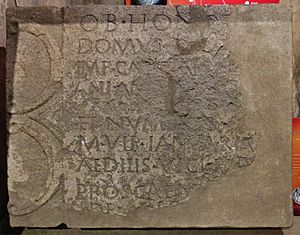Petuaria facts for kids
Petuaria was an ancient Roman fort and town. It was located where the modern town of Brough is today, in the East Riding of Yorkshire, England. The name Petuaria might mean 'quarter' or 'fourth part'. It comes from an old British word, similar to the Welsh word for 'four'.
The Romans built the fort in 70 AD. They left it around 125 AD. A civil town, called a civitas, grew up next to the fort. This town also had a ferry crossing and a port. It lasted until about 370 AD. Petuaria was likely the main town for a Celtic tribe called the Parisi. It was also the southern end of a Roman road known as Cade's Road. This road went north for about 100 miles to Pons Aelius (modern Newcastle upon Tyne). The part of the road from Petuaria to Eboracum (York) was also the end of Ermine Street.
Discovering Ancient Petuaria

People have dug up the site of Petuaria many times. The first big digs happened in the 1930s. More work took place between 1958 and 1962. Smaller digs have happened since then.
One very important find was a stone from the Roman theatre. This stone is special because it mentions a Roman official. His name was Marcus Ulpius Januarius. The stone says he gave a stage to the town. This happened around 140 AD. It shows how advanced the town was. The stone was later reused in the town's defenses. This shows how things changed over time. People started to focus more on protecting their town.
Why Petuaria Was Important
Petuaria was very important because of its location. It was like an early version of the modern city of Kingston upon Hull. The Humber estuary was a key way to travel into England. Many rivers flow into the Humber from the North Sea. These include the Ouse, Hull, Derwent, Wharfe, Aire, Don, Trent, and Ancholme.
This made Petuaria a great place for trade and travel. A large mosaic found nearby shows eight river goddesses. Some people think these goddesses represent these important rivers. They show how vital the rivers were for transport in Roman times.
The Brantingham Roman Villa
Just outside Brough was a Roman country house, or villa, at Brantingham. It was found in 1941. This villa was likely connected to Petuaria. It burned down around the mid-4th century AD.
In 1948, something strange happened at the villa site. Archaeologists found beautiful mosaic floors. They were getting ready to move one mosaic to a museum. But overnight, it was stolen! The other mosaics were saved and are now in the Hull and East Riding Museum. But the first one has never been found.


